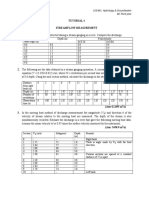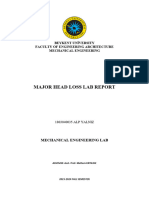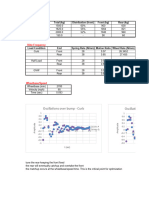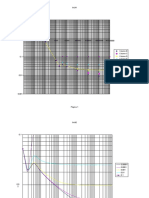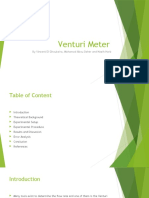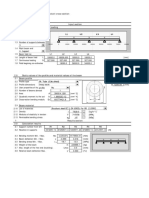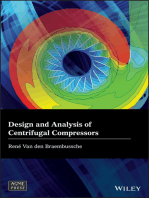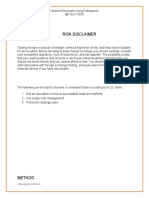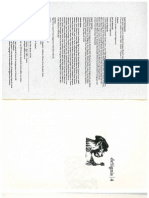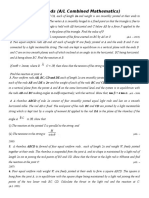Practice #2: Bernoulli Equation: Hydraulics Lab Professor: Jose Manuel Molano Martínez
Practice #2: Bernoulli Equation: Hydraulics Lab Professor: Jose Manuel Molano Martínez
Uploaded by
MikeOriginal Description:
Original Title
Copyright
Available Formats
Share this document
Did you find this document useful?
Is this content inappropriate?
Report this DocumentCopyright:
Available Formats
Practice #2: Bernoulli Equation: Hydraulics Lab Professor: Jose Manuel Molano Martínez
Practice #2: Bernoulli Equation: Hydraulics Lab Professor: Jose Manuel Molano Martínez
Uploaded by
MikeCopyright:
Available Formats
Practice #2: Bernoulli
Equation
Hydraulics Lab
Professor: Jose Manuel Molano Martínez
Ana Fernanda González – A01363861
Jonathan Álvarez Suárez – A01204937
Rogelio Tovar Medel - A01701398
Alonso García Roa – A01207701
Campus Querétaro
HYDRAULICS LAB
PRACTICE 2. Bernoulli Equation
Objective:
The reasoning behind the following practice is to apply de Bernoulli equations into some sort of
real-life application in order to demonstrate the correlation between values of velocity, pressure
and so on into the different states of the change of cross-sectional area of the tube.
General Data:
The following table shows the main characteristics of the venturi used during the experimental
procedure:
Table #1 - Dimensions of the Venturi Cross-sections
Tapping Diameter of cross-section (mm) Manometer Height
Position
1 31.75 h1
2 15 h2
3 31.75 h3
Report:
Flowrate #1 (Q1):
Table #2: Flowrate 1 Data
Tapping Diameter Static Pressure Velocity
Flowrate (m3/s)
Position (mm) Deflection H (mm) (m/s)
1 31.75 239 0.222831
0.0001764 2 15 180 0.998344
3 31.75 215 0.222831
Tapping Position Vs. Static Tapping Position Vs. Velocity - Q1
Pressure Deflection - Q1 1.2
300 1
Static Pressure H (mm)
Velocity V (m/s)
250
0.8
200
0.6
150
0.4
100
50 0.2
0 0
0 1 2 3 4 0 1 2 3 4
Tapping Position Tapping Position
2 Practice from Armfield Manual
Campus Querétaro
Flowrate #2 (Q2):
Table #3: Flowrate 2 Data
Tapping Diameter Static Pressure Velocity
Flowrate (m3/s)
Position (mm) Deflection H (mm) (m/s)
1 31.75 264 0.249001
0.0001971 2 15 186 1.115596
3 31.75 231 0.249001
Tapping Position Vs. Static Pressure Tapping Position Vs. Velocity - Q2
Deflection - Q2 1.2
300 1
Velocity V (m/s)
Static Pressure H (mm)
250 0.8
200
0.6
150
0.4
100
0.2
50
0
0
0 1 2 3 4
0 1 2 3 4
Tapping Position
Tapping Position
Flowrate #3 (Q3):
Table #4: Flowrate 3 Data
Tapping Diameter Static Pressure Velocity
Flowrate (m3/s)
Position (mm) Deflection H (mm) (m/s)
1 31.75 323 0.304676
0.0002412 2 15 192 1.365032
3 31.75 274 0.304676
3 Practice from Armfield Manual
Campus Querétaro
Tapping Position Vs. Static Pressure Tapping Position Vs. Velocity - Q3
Deflection - Q3 1.6
350 1.4
Static Pressure H (mm)
300 1.2
Velocity V (m/s)
250 1
200 0.8
150 0.6
100 0.4
50 0.2
0 0
0 1 2 3 4 0 1 2 3 4
Tapping Position Tapping Position
Flowrate #4 (Q4):
Table #5: Flowrate 4 Data
Tapping Diameter Static Pressure Velocity
Flowrate (m3/s)
Position (mm) Deflection H (mm) (m/s)
1 31.75 380 0.340557
0.0002696 2 15 187 1.525788
3 31.75 315 0.340557
Tapping Position Vs. Static Pressure Tapping Position Vs. Velocity - Q4
Deflection - Q4 1.8
400 1.6
350 1.4
Static Pressure H (mm)
Velocity V (m/s)
300 1.2
250 1
200 0.8
150 0.6
100 0.4
50 0.2
0 0
0 1 2 3 4 0 1 2 3 4
Tapping Position Tapping Position
4 Practice from Armfield Manual
Campus Querétaro
1. Analyze and discuss the results. Are they what you would expect based on the
theory?
The predictions were actually spot on, given the fact that a divergence in the velocities
created different values for what’s captioned as position but corresponds to the pressure
stated on a given point, considering the measures with a higher velocity every time in each
second value. This correlation goes with the initially presumed difference as the first
number corresponds to the wider area, and the second to the narrow part of the nuzzle,
and the last one goes to the regression to the first stage.
This could be explained as the raise in pressure on the first point, dropping significantly
(and consequently rising the velocity) on the bottle neck and ending with a difference at
the last one because of what we think is the effect that the water starts slowing down but
hasn't come to an equilibrium just yet.
2. Application of Bernoulli’s equation:
1
2
2g (h1 h5 )
Q A5 d12 d 52
A5
1 ( A )
2
A1 A5
1 where 4 and 4
Table #6: Theorical Flowrate Vs. Experimental Flowrate
Experimental Flowrate (m3/S) Theorical Flowrate (m3/s) Error (%)
0.0001764 0.000195 9.55
0.0001971 0.000224 12.10
0.0002412 0.000291 17.00
0.0002696 0.000350 23.57
3. Compare the predictions from Question 2 to your measured volume flowrates. How
do these theoretical values compare to your lab results?
The theoretical values are similar in order of magnitude towards the practice values,
although there is a considerable error as the height increased (H). The error range is
between 9.55% to 23.57 % in relation to the increase in height. This may be due to the air
voids in the system, the correct performance hydraulic pump and the human error in
reference to the measurements.
5 Practice from Armfield Manual
Campus Querétaro
PRACTICE 2. Bernoulli Equation
Rúbrica de Evaluación
Realizó
correctamente No realizó correctamente las
Realizó correctamente las
las gráficas, sin gráficas, y no contienen títulos
gráficas, con títulos y unidades
títulos y ni unidades
20 puntos
unidades 0 puntos
10 puntos
Respondió No Respondió correctamente
correctamente la pregunta 1 la pregunta 1
10 puntos 0 puntos
Realizó
correctamente No realizó correctamente las
Realizó correctamente las
las gráficas de gráficas de la pregunta 2, y no
gráficas de la pregunta 2, con
la pregunta 2, contienen títulos ni unidades
títulos y unidades
sin títulos y
10 puntos
unidades 0 puntos
5 puntos
Respondió No Respondió correctamente
correctamente la pregunta 3 la pregunta 3
15 puntos 0 puntos
No calculó
Calculó
correctamente en la pregunta
correctamente en la pregunta 4
4
15 puntos
0 puntos
Respondió No Respondió correctamente
correctamente la pregunta 5 la pregunta 5
10 puntos 0 puntos
Realizó Realizó Realizó Realizó Realizó
conclusiones conclusiones conclusiones conclusiones conclusiones
objetivas, poco objetivas, poco objetivas, poco objetivas, subjetivas, sin
comparando comparando comparando sin comparar comparar
resultados resultados resultados resultados resultados
obtenidos, y obtenidos, y obtenidos, y obtenidos, y obtenidos, y no
demostró demostró demostró poco demostró poco demostró
aprendizaje del aprendizaje del aprendizaje del aprendizaje del aprendizaje del
objetivo de la objetivo de la objetivo de la objetivo de la objetivo de la
práctica práctica práctica práctica práctica
20 puntos 15 puntos 10 puntos 5 puntos 0 puntos
6 Practice from Armfield Manual
You might also like
- Venturi Meter and Orifice Plate Lab ReportDocument11 pagesVenturi Meter and Orifice Plate Lab Reportprajwal m100% (1)
- Moment Influence LineDocument17 pagesMoment Influence LineMoganraj89% (19)
- hw#2 PDFDocument5 pageshw#2 PDFEkta VaswaniNo ratings yet
- Active Learning Task 8Document7 pagesActive Learning Task 8haptyNo ratings yet
- Tutorial 4Document2 pagesTutorial 4Irfan Khan100% (1)
- Hydraulic Analysis Report - TORRE ETANOLDocument31 pagesHydraulic Analysis Report - TORRE ETANOLDiana MarcelaNo ratings yet
- 0 - Official Seaborn Tutorial - Seaborn 0.9.0 DocumentationDocument2 pages0 - Official Seaborn Tutorial - Seaborn 0.9.0 DocumentationJusto FuentesNo ratings yet
- MosDocument3 pagesMosrajapratyNo ratings yet
- Table of ContentDocument10 pagesTable of ContentMuhammad UkashaNo ratings yet
- Calibration Curve Between Pressure Drop and Mass Flow RateDocument2 pagesCalibration Curve Between Pressure Drop and Mass Flow RateMikail IsmailNo ratings yet
- Venturi FlumeDocument3 pagesVenturi FlumeditokelomolabeNo ratings yet
- Chart and TableDocument7 pagesChart and Tablenpthaonhi12No ratings yet
- Experiment Portal Frame g3Document13 pagesExperiment Portal Frame g3SUNNYWAY CONSTRUCTIONNo ratings yet
- The University of Birmingham Fluid Mechanics and Energy Transfer (FMET) Laboratory Experiment FMET3 - Pipe LossesDocument5 pagesThe University of Birmingham Fluid Mechanics and Energy Transfer (FMET) Laboratory Experiment FMET3 - Pipe Lossesnan wuNo ratings yet
- Muzahid Latif, Friction Loss Along A PipeDocument10 pagesMuzahid Latif, Friction Loss Along A PipeMuzahid KhatryNo ratings yet
- Typhoon 15040-003800Document2 pagesTyphoon 15040-003800Hernan RiosNo ratings yet
- CalculatorDocument7 pagesCalculatorBesan LaduNo ratings yet
- TA1379 TEC 079 CompressedAirPiping F0.0Document5 pagesTA1379 TEC 079 CompressedAirPiping F0.0BUDI HARIANTONo ratings yet
- Report Moment Influence LinesDocument30 pagesReport Moment Influence LinesismailNo ratings yet
- Drum DataDocument3 pagesDrum DataAnonymous XV9LfaMmNo ratings yet
- MRESISTDocument1 pageMRESISTesNo ratings yet
- Flujo Laminar Entre Dos Placa ParaleleasDocument2 pagesFlujo Laminar Entre Dos Placa ParaleleasGerardo Galindo RamosNo ratings yet
- StreamflowDocument43 pagesStreamflowShoby Kesavan PillaiNo ratings yet
- Hydraulic Analysis Report - B1 - INT-1Document42 pagesHydraulic Analysis Report - B1 - INT-1sunnypawar1996No ratings yet
- Pumps CalculationsDocument9 pagesPumps CalculationsahmadNo ratings yet
- Impact of JetDocument8 pagesImpact of JetbandarNo ratings yet
- Grafik California Bearing Ratio (CBR) : Penurunan (Inch)Document8 pagesGrafik California Bearing Ratio (CBR) : Penurunan (Inch)Arjun HerlambangNo ratings yet
- Air Duct Sizing - SI & Imperial UnitsDocument4 pagesAir Duct Sizing - SI & Imperial UnitsDarshan Patel100% (1)
- STyphoon 12125Document2 pagesSTyphoon 12125Ignacio RinaldiNo ratings yet
- Reynold Experiment CalculationsDocument14 pagesReynold Experiment CalculationsMuhammad Umer RanaNo ratings yet
- Akış Proje HeleshawDocument7 pagesAkış Proje HeleshawHakan SalmanNo ratings yet
- Sampler - Is TcyclicDocument1 pageSampler - Is Tcyclicnag5500No ratings yet
- Experiment 4 Centrifugal PumpDocument9 pagesExperiment 4 Centrifugal PumpSaranya Devi RagupathyNo ratings yet
- Counterbalance ValvesDocument2 pagesCounterbalance ValvesJose MachadoNo ratings yet
- Flow Under Sluice Gate & Demonstration of H.Jump & Flow Over A Triangular WeirDocument12 pagesFlow Under Sluice Gate & Demonstration of H.Jump & Flow Over A Triangular WeirGertjan DuniceriNo ratings yet
- Experiment 04: Behaviour of Reinforced Concrete Beams Under TorsionDocument10 pagesExperiment 04: Behaviour of Reinforced Concrete Beams Under TorsionKhimavathBharathNaikNo ratings yet
- K30 Calculation: Load Intensity Σ (Mpa) Settlement (Dial Gauge Index) S (0.01Mm) Load Plate Settlement (Mm)Document4 pagesK30 Calculation: Load Intensity Σ (Mpa) Settlement (Dial Gauge Index) S (0.01Mm) Load Plate Settlement (Mm)AnwarNo ratings yet
- Pressure Sheet 2010Document29 pagesPressure Sheet 2010Imad AghilaNo ratings yet
- Geometri: Gambar. Geometri Kendali Gambar. Geometri Horizontal BaffleDocument18 pagesGeometri: Gambar. Geometri Kendali Gambar. Geometri Horizontal Bafflekomed diNo ratings yet
- 24K Mech Lab-IS ExtDocument3 pages24K Mech Lab-IS ExtVikasNo ratings yet
- Air Duct Sizing - SI & Imperial UnitsDocument1 pageAir Duct Sizing - SI & Imperial UnitsAbu Jasim K UNo ratings yet
- Stress Sheet Mod For MemoDocument108 pagesStress Sheet Mod For MemoUmar UmarNo ratings yet
- Data TurbineDocument3 pagesData TurbineMuhamad IzzanNo ratings yet
- Lab 1 CalculationDocument4 pagesLab 1 CalculationClinton NdhlovuNo ratings yet
- Catalog For SAITEC Oval Gear Flow MeterDocument13 pagesCatalog For SAITEC Oval Gear Flow Metersy4hrud1n13No ratings yet
- Major Head Loss RaporDocument5 pagesMajor Head Loss Rapor1803040035No ratings yet
- 1.0 Objective: M XB/ L (X A)Document10 pages1.0 Objective: M XB/ L (X A)Junaid MahsudNo ratings yet
- Moment Influence LinesDocument19 pagesMoment Influence LinesSitiNo ratings yet
- Shear Strength of SoilDocument12 pagesShear Strength of SoilSalman ShujaNo ratings yet
- AaaaaaaaaaaaaaaaaaaaaaaaDocument3 pagesAaaaaaaaaaaaaaaaaaaaaaaaHarrison DwyerNo ratings yet
- 丢失文件名的文件Document1,420 pages丢失文件名的文件313934753No ratings yet
- Centrifugal PumpDocument7 pagesCentrifugal PumpOscar Dos SantosNo ratings yet
- Ride Frequency and DampingDocument15 pagesRide Frequency and DampingAjayNo ratings yet
- Ducting Static Pressure LossDocument6 pagesDucting Static Pressure LossOmkarNo ratings yet
- Bombas MoodyDocument6 pagesBombas MoodyAlexCardoso1990No ratings yet
- Compile Calculation MBZDocument6 pagesCompile Calculation MBZLUKMAN DESIGNNo ratings yet
- Venturi Meter: by Vincent El Ghoubaira, Mohamad Abou Daher and Nazih HarbDocument20 pagesVenturi Meter: by Vincent El Ghoubaira, Mohamad Abou Daher and Nazih HarbMohamad Abou DaherNo ratings yet
- Raw Data TorsionDocument2 pagesRaw Data TorsionHanif SaufiNo ratings yet
- Hydraulic Calc - BISHANPURDocument3 pagesHydraulic Calc - BISHANPURAvishek DeyNo ratings yet
- Test Document 3Document89 pagesTest Document 3Ufuk YazganNo ratings yet
- Beam Desain1Document2 pagesBeam Desain1Astri NgentNo ratings yet
- Modern Borehole Analytics: Annular Flow, Hole Cleaning, and Pressure ControlFrom EverandModern Borehole Analytics: Annular Flow, Hole Cleaning, and Pressure ControlNo ratings yet
- Materials Science and Technology of Optical FabricationFrom EverandMaterials Science and Technology of Optical FabricationNo ratings yet
- Hydrology Assignment #1: Due Date: Tuesday March 10Document3 pagesHydrology Assignment #1: Due Date: Tuesday March 10MikeNo ratings yet
- CASa-Planta AltaDocument1 pageCASa-Planta AltaMikeNo ratings yet
- Midas Gen: 1. Design InformationDocument1 pageMidas Gen: 1. Design InformationMikeNo ratings yet
- Practice #5: Flow Over A Broad Crested Weir.: Hydraulics Lab Professor: Jose Manuel Molano MartínezDocument7 pagesPractice #5: Flow Over A Broad Crested Weir.: Hydraulics Lab Professor: Jose Manuel Molano MartínezMikeNo ratings yet
- Practice #1: Hydrostatic Forces: Hydraulics Lab Professor: Jose Manuel Molano MartínezDocument8 pagesPractice #1: Hydrostatic Forces: Hydraulics Lab Professor: Jose Manuel Molano MartínezMikeNo ratings yet
- Practice #9: Pumps in Series and in Parallel: Hydraulics Lab Professor: Jose Manuel Molano MartínezDocument12 pagesPractice #9: Pumps in Series and in Parallel: Hydraulics Lab Professor: Jose Manuel Molano MartínezMikeNo ratings yet
- McGee - Counterexample To Modus PonensDocument11 pagesMcGee - Counterexample To Modus PonensEric_CrowNo ratings yet
- ECE 334-Lecture 30-nMOS - Inverter-DepletionloadDocument7 pagesECE 334-Lecture 30-nMOS - Inverter-DepletionloadBretuoba Nana Yaw YeboahNo ratings yet
- Probability and StatisticsDocument703 pagesProbability and StatisticsPrakash Dhage88% (17)
- How To Predict Dates For Market Reversals Using Pythagores PDFDocument15 pagesHow To Predict Dates For Market Reversals Using Pythagores PDFKukevics MikimakkaNo ratings yet
- Modal Analysis of Rotating Machinery Structures PDFDocument170 pagesModal Analysis of Rotating Machinery Structures PDFAhmed MohammedNo ratings yet
- Assignment-7 Math II Spring 2019Document2 pagesAssignment-7 Math II Spring 2019Account PhoneNo ratings yet
- Rizal at AteneoDocument38 pagesRizal at AteneoSerje Oshiro AbraoNo ratings yet
- 3579 Handbook Reporting 11Document82 pages3579 Handbook Reporting 11Alyssa LNo ratings yet
- January Semester 2023 NBHS1202Document23 pagesJanuary Semester 2023 NBHS1202JKKP HPJBNo ratings yet
- Modul Lulus Add MathDocument21 pagesModul Lulus Add MathLoh Chee WeiNo ratings yet
- Math 118Document9 pagesMath 118Ashwin PalaniappanNo ratings yet
- Antennas & Wave Propagation: Radiation Properties of AntennaDocument153 pagesAntennas & Wave Propagation: Radiation Properties of AntennaRAAJ KISHOR R HNo ratings yet
- Graph Theory: Ayele BDocument67 pagesGraph Theory: Ayele BAbiyot NeguNo ratings yet
- Dotsenko - Intro To Stat Mech of Disordered Spin Systems PDFDocument115 pagesDotsenko - Intro To Stat Mech of Disordered Spin Systems PDFPablo SantanaNo ratings yet
- 1 s2.0 S0168169919311573 MainDocument11 pages1 s2.0 S0168169919311573 MainJuan ZarateNo ratings yet
- Media + Software Meta-MediaDocument2 pagesMedia + Software Meta-MediaaliNo ratings yet
- Fulltext01 PDFDocument80 pagesFulltext01 PDFGiorgio Luigi BorgiaNo ratings yet
- Design Is 4Document145 pagesDesign Is 4Miguel Alejandro Bohórquez NatesNo ratings yet
- 10 1177@1464420719886887Document20 pages10 1177@1464420719886887inakollumaneeshvardhanreddyNo ratings yet
- AdaBoost New PDFDocument45 pagesAdaBoost New PDFRaphaelNo ratings yet
- 11-15-14 Strength of MaterialsDocument60 pages11-15-14 Strength of MaterialsJaypee CalambaNo ratings yet
- Jointed RodsDocument3 pagesJointed RodsJanaka PriyalalNo ratings yet
- Agent-Based Economics and EconophysicsDocument358 pagesAgent-Based Economics and Econophysicsmnbvghjk100% (1)
- Assignment 1Document3 pagesAssignment 1Syakira WahidaNo ratings yet
- CTP Water PumpsDocument2 pagesCTP Water PumpsSERGIOEDWARDONo ratings yet




